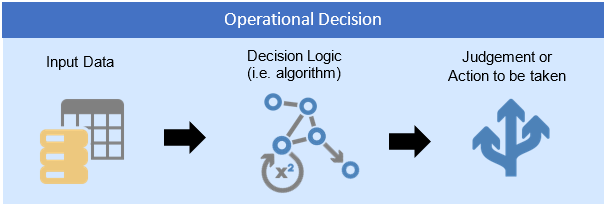It may sound routine, but the importance of operational decisions cannot be underestimated. After all, not a day goes by without even the smallest business making dozens, if not hundreds of operational decisions that may affect the bottom line. Elevate these to large scale companies and we are talking thousands, if not millions of actions that impact day-to-day business operations.
So what do we mean by ‘operational decisions’? The dictionary tells us that a decision is a ‘conclusion or resolution reached after consideration’. It is defined as ‘the action or process of deciding something or of resolving a question’.
From this straightforward definition, we might construe that an operational decision must have an outcome based on a procedure that is designed to resolve an everyday or, in most cases, an ‘unexceptional’ occurrence. This can be called the ‘decision logic’.
It is important to point out, however, that there are differences between operational decisions and those that may be viewed as strategic to the business. Operational decisions are often highly structured, repetitive and routine. In other words, you can model them once and then reuse them ad infinitum for hundreds or thousands of every day transactions. For example, an operational decision may consider compliance with state regulations, or the possibility of a fraudulent transaction, or a calculation of taxation, or an exception to a claims process.
This is precisely why operational decisions are very often excellent candidates for automation.
To demonstrate, an operational decision structure typically looks something like this:

Operational Decision structure. It includes the “decision logic”, input data and the conclusion.
The judgement or action to be taken in each case could involve a list, a simple value, a calculation, a configuration, a price, a guideline, and several other routine outcomes. For example, it could be a list of available options for treatment of a patient, or the best prices for upselling and product bundling, or a billing calculation for a customer, or specific procedures and guidelines, and so on.
The bottom line is that all operational decisions require an input in order to describe parameters, situations and cases. The decision logic is then executed and a result is produced.
The critical piece here is a combination of effectiveness and efficiency, especially when businesses today are challenged by rapid change and competitive pressure. Yet it is a fact that in many cases, the actual logic behind an operational decision is not at all transparent to the organization. That may be because it is buried in legacy processes and applications or embedded in the minds of subject matter experts who will inevitably move on to other pursuits in a matter of time.
The Importance of Automating Operational Decisions
All too often companies use traditional approaches in an attempt to harness operational decisions. This might involve building applications using code and low-code platforms, iBPMS and other technologies. The problem, of course, is that the operational decision becomes ‘set in stone’, as it is buried in some hard-coded application that is difficult to change. As an interim solution when change request delays occur, some may try to compensate by resorting to Excel and other spreadsheet solutions. Other business-oriented solutions like Business Rules Management Systems (BRMS), Business Process Management (BPM) and Decision Management Systems (DMS) may also come into play as companies seek to memorialise their operational decision-making processes.
The problem with these types of traditional approaches is that when these are challenged by the necessary frequency of high volume changes inherent in operational decision-making, they must be managed independently. This in turn means that decision management becomes a maintenance nightmare. In short, the organisation simply cannot keep pace with the rate of essential change to operational decisions. It is simply not enough to change one line of code or one business rule here and there while other necessary changes stay in queue until such time as someone has time to explore the deep, dark recesses of traditional systems and figure out what to do. This approach inevitably leads to less effective results.
Obviously, there is an essential need to balance the control between IT and the business by using a solution that meets the need for effective and efficient operational decision-making. That’s where FlexRule comes in. Read more about our ground-breaking solutions at www.flexrule.com.